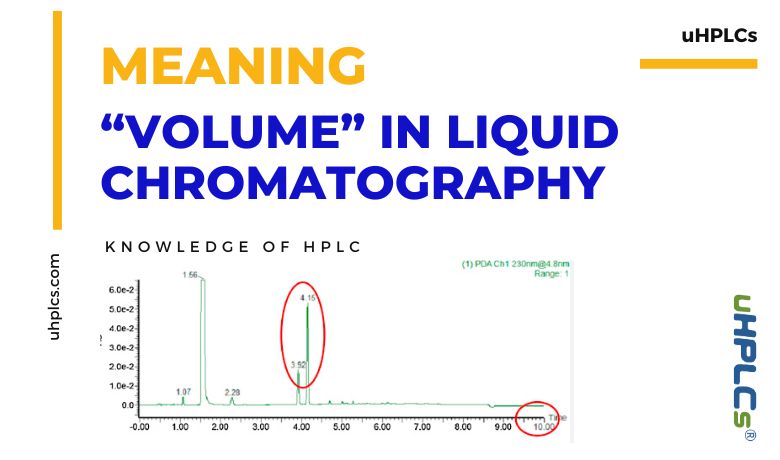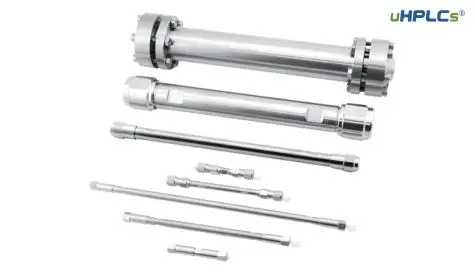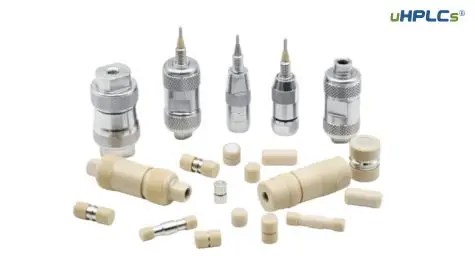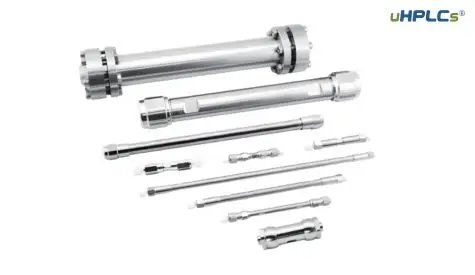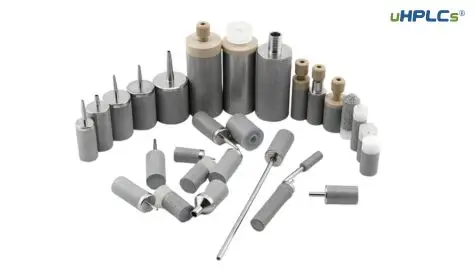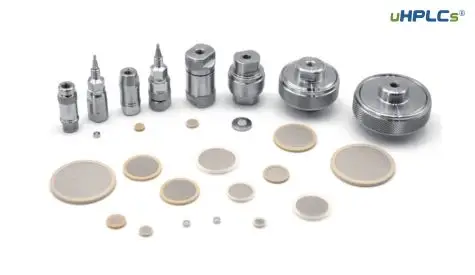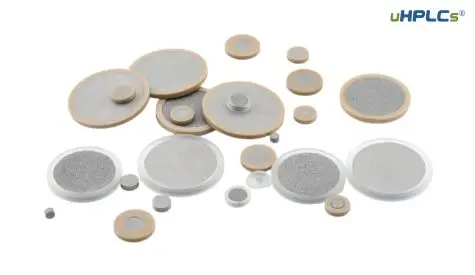In liquid chromatography (LC), “volume” can have several different meanings depending on the context. Here are three main interpretations:
1. Void volume (Vm):
This refers to the total volume of liquid (mobile phase) contained within the column. It essentially represents the space not occupied by the stationary phase particles. Void volume is important for understanding retention times and peak elution, as it influences how long it takes for analytes to travel through the column.
2. Retention volume (Vr):
This refers to the volume of mobile phase that needs to flow through the column to elute a specific analyte. It depends on both the void volume and the analyte’s interaction with the stationary phase. A more strongly-retained analyte will have a larger retention volume compared to a weakly-retained one.
3. Injection volume and detector flow volume:
These refer to the actual volume of sample injected into the system and the volume of mobile phase flowing through the detector per unit time, respectively. Both are important parameters for optimizing sensitivity and resolution in LC analyses.
To understand the specific meaning of “volume” in a particular context, you need to consider the surrounding information and the type of liquid chromatography technique being used. For example, when discussing isocratic elution, void volume or retention volume might be more relevant, while in gradient elution, the volume of the gradient mixture and its delivery profile may be more important.
4. Dead Volume
dead volume! It’s a sneaky little bugger in the world of liquid chromatography (LC), often lurking unseen but potentially impacting your precious analyses. So let’s shed some light on this hidden player.
Think of dead volume as any excess space within the LC system where the mobile phase just hangs out, not contributing to the actual separation of your analytes. It can occur in various places, like:
- Tubing connections: Those extra twists and turns in the tubes add up, creating pockets where your precious sample molecules might dawdle instead of racing through the column.
- Injector parts: Even the injector itself can have hidden nooks and crannies where analytes can get temporarily trapped, delaying their journey.
- Detector flow cell: Sometimes, the detector’s flow cell might be larger than necessary, leading to some mobile phase stagnating and not contributing to the signal measurement.
Here for this article we will deep talking for the dead volume, let’s check details.
What is Dead volume
Dead volume refers to the volume of liquid (mobile phase) within the LC system that does not contribute to the separation of analytes. It exists in the space between the effective injection point and the effective detection point, excluding the portion of the column filled with the stationary phase.
Components:
Dead volume typically consists of four parts:
- Inlet tubing volume: The volume of the tubing between the injector and the column entrance.
- Extra-column void volume (Vm): The volume of mobile phase within the column that is not occupied by the stationary phase particles. This is the only part involved in the chromatographic equilibrium process and contributes to retention times.
- Outlet tubing volume: The volume of the tubing between the column exit and the detector entrance.
- Detector flow cell volume: The volume of the chamber within the detector where the mobile phase flows past the sensor.
Impact on Chromatography:
- Peak broadening: The other three parts of dead volume (excluding Vm) act as zones where analytes spend extra time, causing their peaks to broaden and hindering resolution, especially for closely eluting components.
- Reduced sensitivity: Analytes trapped in dead volume may not reach the detector, leading to lower signal intensity and potentially missed peaks.
Minimizing Dead Volume:
To improve chromatographic performance, it is crucial to minimize dead volume. This can be achieved by:
- Using short and narrow tubing connections.
- Choosing low-volume injectors and detectors with small flow cells.
- Optimizing the packing of the stationary phase to reduce extra-column void volume.
Dead Time:
Dead time is the time it takes for a non-retained molecule to travel through the dead volume. It is directly related to the dead volume and inversely proportional to the flow rate. Knowing the dead time can help estimate the retention times of other analytes.
Commonly Used Dead Volume Markers:
Uracil, acetone, and thiourea are frequently used as dead volume markers in reversed-phase chromatography due to their minimal interaction with the stationary phase.
Calculating Dead Volume in HPLC
Dead volume, the hidden enemy of peak sharpness in HPLC, represents the extra space where your analytes can linger and broaden their peaks, hindering resolution. But fear not, HPLC warriors! We can unveil and conquer this foe by calculating its volume.
Why Calculate Dead Volume?
Minimizing dead volume is key to sharp peaks and clear resolution. The larger the maze, the more your analytes get lost in its twists and turns, leading to:
- Broadened peaks: Think of them as traffic jams, obscuring smaller peaks and making analysis harder.
- Reduced sensitivity: Some analytes might get stuck in the maze, never reaching the detector and leaving you with weaker signals.
So, how do we calculate this sneaky volume?
Here’s your HPLC detective kit:
- Dead time (t₀): This is the time it takes for a non-retained molecule (think of them as speedy couriers) to travel through the maze. Inject a special solution that doesn’t interact with the stationary phase and measure the peak’s retention time. That’s your t₀!
- Flow rate (F): This is the speed of the mobile phase, like the traffic flow in the maze. Measure the flow rate of your HPLC system.
The grand reveal:
Multiply dead time by flow rate, and voila! You have the dead volume (V₀):
V₀ = t₀ × F
With this knowledge, you can optimize your HPLC system by using:
- Short and narrow tubing: Think of wider roads for faster flow.
- Low-volume injectors and detectors: Smaller chambers mean less room for traffic jams.
- Optimized column packing: Reduce those pesky alleyways!
Remember, a well-calculated and minimized dead volume means sharper peaks, clearer resolution, and ultimately, a triumphant HPLC analysis!
How to Reduce the dead volume
In the process of use or maintenance, if it involves the replacement of pipeline and other accessories, we should choose the accessories with the same specifications to ensure that the dead volume is the same as the original, to avoid the increase of dead volume and bring the spreading of peak shape.
When installing the column, make sure that the pipeline connectors are well-matched (pay special attention to the use of peeking tubing connectors and the connection between the pipeline and the column) to avoid the formation of joint cavities (as shown below).
So when should I choose which joint?
Stainless steel couplings are the best choice for reliable high-pressure sealing
pressure-type fittings with front and rear gaskets – for optimal sealing performance – available for all liquid chromatography systems on the market
PEEK (<400 bar system pressure) fittings are suitable for:
Frequently changed connections, e.g. for connecting different columns – Low-pressure requirements.
PEEK and polyketone couplings are suitable for connections that need to be changed frequently or when biocompatibility is required. The maximum operating pressure is 200 bar for PEEK fittings and 600 bar for polyketone fittings.
Definition of standing volume
The standing volume is the volume between the point of the first solvent mixing (usually in the liquid chromatograph’s mixing chamber or the proportioning valve) and the head of the liquid chromatography column. In this case, the standing volume of a low-pressure mixing system is equal to the sum of the volumes from the proportional valve through the pump and other system components to the column head.
The standing volume of the high-pressure mixing system is equal to the sum of the volumes from the point where the solvent is mixed, through the two metering pumps, and then to the column head. In isocratic separations, the retention volume does not affect retention time, while in gradient separations, it can have a significant effect.
Failure to understand the standing volume of the system can have serious implications, as the standing volume can be much larger than the column volume.
Same HPLC column, different instruments
Suppose you want to use the same size column on different instruments. In that case, you often need to consider the issue of standing volume, as instruments with different standing volumes using the same method may also affect the analytical results. When starting the gradient elution at the head of the column, you need to ensure that the mobile phase volumes through the column are the same. The results will be different if the mobile phase volumes are not the same.
Suppose the same method is used in two labs for HPLC instruments with different residual volumes. In that case, the run results will likely not be identical because the two (or more) mobile phases mixed to form the gradient will take a different amount of time in each instrument’s flow path before reaching the column head. Therefore, the retention time and separation of the analytes will be affected by the time after injection, as they will pass through different mobile phase components. If the gradient method is transferred from one instrument to another, the retention time will change depending on the residual volumes of the two systems. The closer the flow path volumes are, the higher the agreement of the results.
Differences in results, if any, can be corrected using various methods. If the retention volume of the instrument is small, the retention volume can be adjusted by increasing the instrument’s volume; if the instrument’s retention volume is large, the inner diameter and length of the instrument connection line can be reduced. In addition, a gradient delay can be set in the method to compensate for the different residence times in the flow path system.
Delay Volume
Delayed volume refers to the volume between the solvent mixing point (usually in a liquid chromatograph’s mixing chamber or a proportional valve) and the LC column head.
The delayed volume is important to allow the column to complete the change in mobile phase composition as short as possible when the solvent composition changes for gradient elution or isocratic elution. Low-pressure mixture systems generally have a larger residence volume than high-pressure mixture systems.
Delay volume reduction
As the delay volume varies from instrument to instrument, it may impact the separation and retention time when running gradient methods and may also impact method transfer or validation. The larger the delay volume, the greater the potential impact. The larger the delay volume, the longer it takes to reach the column after changing the gradient ratio, especially at low flow rates.
There are three main approaches to reducing the effect of different retention volumes on separation effectiveness.
First (and best), some system controllers can inject the sample at a precise time after the gradient has started. If the injection time tD is delayed, the gradient and the sample can reach the column inlet simultaneously.
Second, suppose a period of the isocratic process can be inserted at the beginning of the gradient process. In that case, this process can be shortened with a system with a larger VD value and extended with a smaller VD value. In this way, the sample and the gradient will reach the column inlet at the same time.

